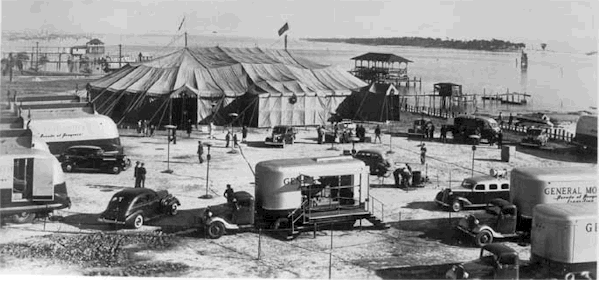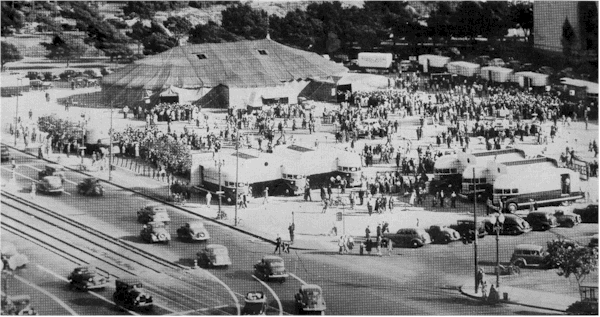1936 Parade of Progress
In 1936, the first Parade assembles in front of Detroit’s downtown GM Building.
General Motors’ interest in using the circus as a means of advertising its products has a long history. Sometimes they displayed their vehicles in the menageries, or arranged for circus parades to arrive at their various dealerships. In 1938, the Hagenbeck Wallace Circus had a fleet of five Chevrolet conversion trucks that were the principal means of towing wagons from the train to the show-grounds.
In addition to these paid promotions, GM produced a complete tent show of their own on two occasions, the first being in 1936, which was organized in Detroit and moved south to Florida in a close caravan. Giving the caravan a send-off were none other than Alfred P. Sloan and Charles "Boss Ket" Kettering. No performances were given in Detroit or any of the cities en route to Florida. The plan was to get maximum publicity from the caravan itself by having it move south, visiting GM assembly plants and some of the larger dealers along the way. The fleet of unusual trucks were displayed at each site for view by employees, the public, and, of course, the press. However, the tents and midway would not be set until they reached Florida.
GM wanted attention even when the show passed on the highway, so all movement was handled as a military convoy. A Cadillac command car was in the lead and communicated with some of the trucks back in the pack by short wave radio. An assortment of automobile models from all GM divisions were included in the convoy. Drivers always wore uniforms on the road, when visiting GM plants or when performing, although white coveralls were provided for workdays when the exhibit was being erected.
Travel was slow, partly because GM wanted everyone the convoy passed to get a good look and partly because the streamlined trucks were seriously underpowered by today’s standards. GM’s small truck engines were based on the flat head Oldsmobile block and offered displacements of only 230-257 cid. The trucks had a 4-speed transmission with a very low first gear that the drivers called "creeper." This was needed on many hills. Because the vacuum power brakes were not as effective as might have been desired, downshifting was the rule on most hills. In addition to the eight streamliners, the fleet included conventional GM trucks, including semis, that carried the big top, chairs, an electric light plant and mechanics’ supplies.
Moves were always made in daytime for publicity, so personnel were boarded in hotels and ate in restaurants. Life in this "circus" was easier than in most traveling shows. Drivers were paid $100 a month; uniforms, coveralls, and hotel rooms were provided; and the food allowance was $18.50 a week, which, in 1936, allowed them to dine well. Like the traditional circus, the Parade of Progress had an advance agent who traveled ahead booking lots, parking space, hotels, and other needs.
Moves were always made in daytime for publicity, so personnel were boarded in hotels and ate in restaurants. Life in this "circus" was easier than in most traveling shows. Drivers were paid $100 a month; uniforms, coveralls, and hotel rooms were provided; and the food allowance was $18.50 a week, which, in 1936, allowed them to dine well. Like the traditional circus, the Parade of Progress had an advance agent who traveled ahead booking lots, parking space, hotels, and other needs.After the caravan arrived in Lakeland, FL, the tents and midway were set up for the first time and the full performance was rehearsed. The big top was a two-pole tent with the stage in the middle of one long side. Seats were opposite the state and in both ends. One of the streamliners unfolded to form the stage, and another was behind the center section of seats, containing an enclosed movie projection booth for films that were part of the program. Performances consisted of juggling, magic, and scientific demonstrations tied in with product displays. This may have been the first time that microwave cooking was demonstrated – emcee Erie Foss cooked an egg on a handkerchief with no protection from the radiation.
GM’s first Parade of Progress opened in Feb. 1936 at Lakeland. FL. Streamliners were tied together with awnings, and the command car was a stretched 1936 Chevrolet.
While the canvas boss and his workmen set up the tent and seats, the drivers set up the exhibits. The truck fleet included eight streamliners, three of which were used for a walk-through midway display. They were parked in a parallel arrangement several feed apart. The sides split apart horizontally so that the upper halves joined to form a roof and the lower halves formed a floor. Side panels carried in the truck enclosed the space, and the tree trucks thus connected formed a continuous hall filled with exhibits. Patrons entered the front truck and exited the rear truck. The show opened in St. Petersburg, FL, followed by Tampa, Miami, and then went up the East Coast, hitting most of the major cities along the way.
After the tour ended the equipment was stored and eventually sold, including the streamliners. Several of these easily recognized trucks have turned up in other service. The streamliner that formed the stage is shown being used for a USO Motor Camp Show performance in 1941 in the book, U.S. Military Wheeled Vehicles, where author F. W. Crismon lists it in the 5-ton category.
The first Parade of Progress consisted of 8 huge, red-and-white(silver?), streamlined vans. The vans were custom built by Fisher Body's Fleetwood plant in Detroit. All eight were on a 223-inch truck chassis and were powered by GMC gasoline engines. Six of the Streamliners formed walk-through exhibits when joined together, three by three, with canvas awnings. Another van opened up to form a stage, and the eighth carried equipment.
The 1936 Parade also used nine GMC and Chevrolet tractor-trailers. These hauled gear, tents, power generators, lamps, booths and additional exhibits. The Streamliners and support vehicles would arrive in town, set up a large tent, and put on a free scientific and educational show. The show was similar to that seen at the General Motors exhibit at the 1933-34 Chicago Worlds Fair.
This photo is a rare snapshot of the 1936-1940 Parade of Progress layout. The photo, unfortunately, doesn't show a good picture of a Streamliner (of which 8 were built), but the back end of a few of them can be seen to the far left of the picture. We're not positive where this photo was taken, but it could have been Cuba. The Parade did visit Cuba in 1937 and it's obviously a beach setting with palm trees.
It's not know where this picture was taken either, but if you study it carefully, you can see the Streamliners on the right hand side of the picture all lined up. Notice the open access door toward the rear of the first vehicle.
*Much of the preceding article was written by Fred Fairbrother and Bill Rhodes, Louisville, Kentucky. Fred W. Fairbrother was truck driver for the 1936 Parade of Progress: he supplied the photographs for that year. Bill Rhodes is a member of ATHS and has previously contributed to Wheels of Time. This article was published in the VOL. 22, No. 1 January/February 2001 American Truck Historical Society Wheels of Time.





